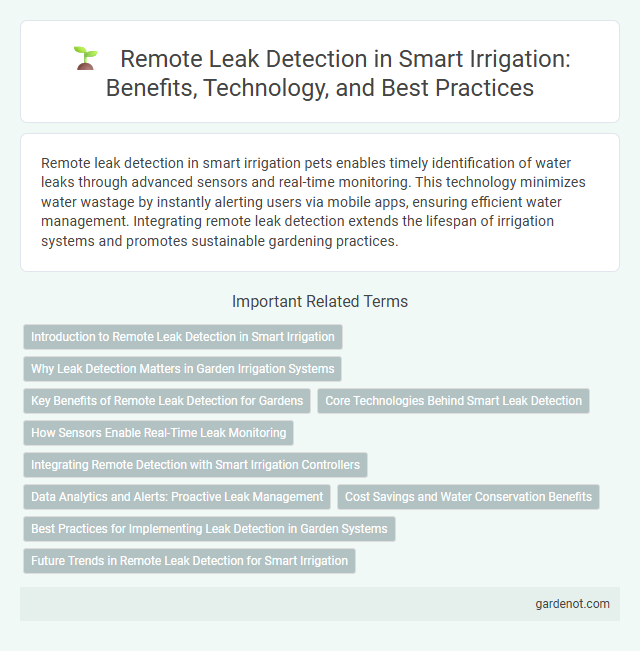Remote leak detection in smart irrigation pets enables timely identification of water leaks through advanced sensors and real-time monitoring. This technology minimizes water wastage by instantly alerting users via mobile apps, ensuring efficient water management. Integrating remote leak detection extends the lifespan of irrigation systems and promotes sustainable gardening practices.
Introduction to Remote Leak Detection in Smart Irrigation
Remote leak detection in smart irrigation utilizes IoT sensors and real-time data analytics to identify water leaks quickly, minimizing water waste and optimizing system efficiency. Advanced algorithms analyze soil moisture levels, flow rates, and pressure changes to detect anomalies indicative of leaks, enabling proactive maintenance and reducing operational costs. Implementing remote leak detection enhances sustainability by conserving water resources and improving crop yield through precise irrigation management.
Why Leak Detection Matters in Garden Irrigation Systems
Leak detection in garden irrigation systems prevents water waste by identifying hidden pipe or emitter leaks that reduce efficiency and increase costs. Early detection safeguards plant health by ensuring consistent water delivery and avoiding over-saturation or dry patches. Remote leak detection technology enables timely alerts and maintenance, preserving resource conservation and sustainability goals.
Key Benefits of Remote Leak Detection for Gardens
Remote leak detection in smart irrigation systems significantly reduces water wastage by instantly identifying leaks and malfunctions. This technology enhances garden health by maintaining consistent moisture levels, promoting optimal plant growth and reducing the risk of root diseases caused by overwatering. It also lowers maintenance costs through early leak identification, preventing extensive damage and conserving water resources efficiently.
Core Technologies Behind Smart Leak Detection
Core technologies behind smart leak detection in irrigation include advanced sensors such as soil moisture sensors, flow meters, and pressure sensors that continuously monitor water usage and system anomalies. IoT connectivity enables real-time data transmission to cloud platforms where machine learning algorithms analyze patterns to identify leaks with high accuracy. Integration with automated shutoff valves allows immediate response to detected leaks, reducing water waste and preventing damage.
How Sensors Enable Real-Time Leak Monitoring
Sensors equipped with advanced moisture and pressure detection capabilities enable real-time leak monitoring by continuously analyzing water flow patterns and soil hydration levels. These devices promptly identify anomalies indicative of leaks, allowing for immediate alerts and targeted maintenance interventions. Integrating sensor data with smart irrigation systems enhances water conservation and reduces operational costs by preventing water waste and damage.
Integrating Remote Detection with Smart Irrigation Controllers
Integrating remote leak detection with smart irrigation controllers enhances water efficiency by enabling real-time monitoring and automatic adjustments based on detected leaks. Sensors and IoT devices communicate directly with the controllers to shut off or reduce water flow when a leak is identified, minimizing water waste and preventing landscape damage. This seamless integration supports sustainable irrigation practices by optimizing water usage and reducing maintenance costs.
Data Analytics and Alerts: Proactive Leak Management
Remote leak detection leverages advanced data analytics to continuously monitor irrigation systems, identifying anomalies in water flow and usage patterns that indicate leaks. Real-time alerts enable immediate response, minimizing water waste and reducing operational costs. Integrating machine learning algorithms enhances predictive capabilities, ensuring proactive leak management and optimized irrigation efficiency.
Cost Savings and Water Conservation Benefits
Remote leak detection in smart irrigation systems significantly reduces water waste by identifying leaks early, preventing costly damages and excessive water usage. Implementing this technology leads to substantial cost savings on water bills and minimizes the environmental impact associated with over-irrigation. Efficient leak detection supports sustainable water management, enhancing both economic and ecological outcomes for agricultural and landscaping operations.
Best Practices for Implementing Leak Detection in Garden Systems
Implementing remote leak detection in garden irrigation systems requires installing high-sensitivity soil moisture sensors and smart flow meters to monitor real-time water usage and identify anomalies promptly. Integrating these devices with IoT platforms enables automated alerts and precise localization of leaks, reducing water waste and preventing plant damage. Regular calibration of sensors and routine system maintenance ensure consistent accuracy and long-term reliability in smart irrigation leak detection.
Future Trends in Remote Leak Detection for Smart Irrigation
Future trends in remote leak detection for smart irrigation emphasize the integration of AI-driven predictive analytics and real-time sensor networks to enhance water efficiency and minimize wastage. Advanced IoT devices equipped with ultrasonic and acoustic sensors enable continuous monitoring and precise localization of leaks, reducing response times significantly. The adoption of edge computing and 5G connectivity further supports scalable, low-latency detection systems, transforming water management in agriculture and landscape irrigation.
Remote leak detection Infographic

 gardenot.com
gardenot.com